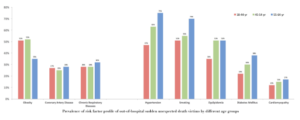 “9-1-1 … Hello! Somebody just collapsed on MLK Road near the Root Cellar café,” said a bystander as he rushed towards the man lying still in the parking lot. A second young man on the scene was already performing CPR.
“9-1-1 … Hello! Somebody just collapsed on MLK Road near the Root Cellar café,” said a bystander as he rushed towards the man lying still in the parking lot. A second young man on the scene was already performing CPR.
The bystander asked the young man, “What just happened? I saw him walking a few minutes ago and he seemed fine.”
The young man responded with a broken voice: “Andrew is our neighbor. I don’t know what happened. I found him unresponsive and lying on the ground beside his car door.”
This unfortunate scenario is most commonly attributed to sudden cardiac (heart) death, which is defined by the World Health Organization as a death occurring within an hour of symptom onset or an unexpected death within 24 hours of having been seen alive. This definition is restricted by timing and manner of death, and also assumes that death within this time frame is due to a cardiac event. This often results in the mischaracterization of non-cardiac incidents of sudden death. Seeking to address these limitations in the examination of sudden death, both due to cardiac and noncardiac causes, physician scientists in the Division of Cardiology at the University of North Carolina at Chapel Hill Hospital initiated a project studying all causes of out-of-hospital sudden unexpected death in North Carolina. This initiative is called the SUDDEN Project.
What is the SUDDEN Project?
Sudden death is a term encompassing all causes of out-of-hospital sudden unexpected death (SUD). The SUDDEN project, led by principal investigator Ross J Simpson Jr., was piloted in Wake County, North Carolina in March 2013. All natural deaths, regardless of underlying cause, were studied. “Unexpectedness” was determined based on the location of death, manner of death, and medical history in persons aged 18 to 64. Victims who had an unexpected death were characterized based on their demographic and medical disease profile to understand the risk factors. As our understanding advances regarding sudden deaths, we can begin to understand risk factors for both cardiac and non-cardiac deaths. The initiative has now expanded to more than 10 counties in North Carolina and a few counties in South Carolina.
Why is it important to study out-of-hospital sudden unexpected death?
Previously, sudden death had been considered to be an unpredictable first sign of an underlying disease. However, Lewis M.E., et.al , described out-of-hospital SUD as a syndrome with a hefty price tag, with 1 out of 3 victims characterized as high utilizers of the health care system. These individuals die not only due to cardiac events such as heart attacks, but also due to worsening chronic diseases including diabetes, hypertension, obesity, lung disease, and kidney disease. Investigators described risk factors and medical disease profiles of out-of-hospital SUD victims by different age groups. All of these diseases decrease quality of life for their victims, and this deterioration is primarily due to frequent hospitalizations, clinic visits, and emergency department visits. Sudden death victims also can suffer from unaddressed mental health issues, exacerbating the management of their baseline chronic disease. Out-of-hospital SUD is not only an individual burden, but also a familial and a societal burden. This loss of life incurs countless unforeseen medical and end-of-life expenses. However, these costs do not begin to compare to the emotional impact on the families of those who die suddenly. These economic and emotional burdens could be minimized by identification and treatment of underlying diseases that eventually cause sudden death. Identifying risk factors to predict SUD victims could allow for timely interventions and prevent their death.

Future of out-of-hospital sudden unexpected death prevention
Characterizing the profiles of out-of-hospital SUD victims will lead to the development of strategies focused on intervention planning. This will identify and treat the potential out-of-hospital SUD victims. In order to develop community-based paramedicine programs, SUDDEN has developed close collaborations with the Gillings School of Public Health, the ODUM Institute, and the Eshelman School of Pharmacy at UNC, as well as the Emergency Medical Services of several counties. They have also developed national collaborations with both the Environmental Protection Agency and the Center for Disease Control. These collaborations will aim to build a framework of targeted prevention plans through meaningful partnerships with community health partners across North Carolina and the United States to provide adequate access to health care resources and social support networks. The SUDDEN Project is fortunate enough to welcome students from multiple educational backgrounds to collaborate on their ongoing projects. For general inquiries and/or questions, please email sudden@med.unc.edu.
Peer edited by Michelle Engle and Nicole Tackmann.
Follow us on social media and never miss an article: